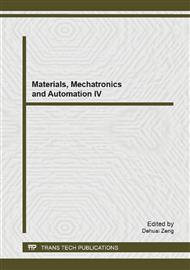[1]
J.O. Metzger, M. Eissen: Concepts on the contribution of chemistry to a sustainable development. Renewable raw materials, Comptes Rendus Chimie, 7: 1–13 (2004).
DOI: 10.1016/j.crci.2003.12.003
Google Scholar
[2]
H.G.B. Premalal, H. Ismail, A. Baharin: Comparison of the mechanical properties of rice husk powder filled polypropylene composites with talc filled polypropylene composites, Polymer Testing 21: 833–839 (2002).
DOI: 10.1016/s0142-9418(02)00018-1
Google Scholar
[3]
H.S. Kim, H.S. Yang, H.J. Kim: Biodegradability and mechanical properties of agro-flour-filled polibutylene succinate biocomposites, J Appl. Poly. Sci, 97: 1513-1521 (2005).
DOI: 10.1002/app.21905
Google Scholar
[4]
N.S. Suharty, and M. Firdaus: Synthesis of degradable bio-composites polystyrene recycle modified in reactively process using natural fibre filler, Proceeding of 12th Asian Chemical Congress, Kuala Lumpur, Malaysia (2006).
Google Scholar
[5]
M. Sain, J. Balatinecz, S. Law: Creep fatigue in engineered wood fibres and plastic compositions. J Appl. Poly. Sci., 77: 260 (2000).
DOI: 10.1002/(sici)1097-4628(20000711)77:2<260::aid-app3>3.0.co;2-h
Google Scholar
[6]
N.S. Suharty, B. Wirjosentono, M. Firdaus, D.S. Handayani, J . Sholikhah, Y.A. Maharani: Synthesis of degradable bio-composites based on recycle polypropylene filled with bamboo powder using a reactive process, J. Phys. Sci., 19: 105–115 (2008).
Google Scholar
[7]
H. Ismail, M.R. Edyham and B. Wirjosentono, Bamboo Fiber Filled Natural Rubber Composites: The Effects of Filler Loading and Bonding Agent, Polymer Testing, 21: 139-144 (2002).
DOI: 10.1016/s0142-9418(01)00060-5
Google Scholar
[8]
Bourbigot Serge, Duquesne Sophie: Fire Retardant Polymer: Recent Developments and Opportunities, J. Mater. Chem., 17: 2283-2300 (2007).
DOI: 10.1039/b702511d
Google Scholar
[9]
M. Sain, S.H. Park, F. Suhara, S. Law: Flame retardant and mechanical properties of natural fiber–PP composites containing magnesium hydroxide, Poly. Deg. and Stab. 83: 363–367 (2004).
DOI: 10.1016/s0141-3910(03)00280-5
Google Scholar
[10]
A.A. Aziz Ahmad, S.M. Alauddin, R.M. Saleh, Sabet Maziyar: Influence of Magnesium Hydroxide/Aluminum Tri-hydroxide Particel Size on Polymer Flame Retardancy: An Overview. Int of Chem Eng Appl., Vol 3 No 6 (2012).
DOI: 10.7763/ijcea.2012.v3.238
Google Scholar
[11]
Hao Tang, Xiao-Bai Zhou, Xiao-Lu Liu: Effect of Magnesium Hydroxide on the Flame Retardant Properties of Unsaturated Polyester Resin. ProcediaEngeenering., 52: 336-341 (2012).
DOI: 10.1016/j.proeng.2013.02.150
Google Scholar
[12]
N.S. Suharty, I.P. Almanar, Sudirman, K. Dihardjo, N. Astasari: Flammability, Biodegradability dan Mechanical Properties of Bio-Composites Waste Polypropilene/Kenaf Fiber Containing Nano CaCO3 with Diammonium Phosphate, Procedia Chemistry, vol. 4: 282-287 (2012).
DOI: 10.1016/j.proche.2012.06.039
Google Scholar
[13]
B.R. Ilic, A.A. Mitrovic, and L.R. Ljiljana: Thermal Treatment of Kaolin Clay to Obtain Metakaolin. Hem. Ind 64(4): 351-356 (2010).
DOI: 10.2298/hemind100322014i
Google Scholar
[14]
A. Nagieb Zenat, A. Nassar Mona, G. El-Meligy Magda: Effect of Addition of Boric Acid and Borax on Fire-Retardant and Mechanical Properties of Urea Formaldehyde Saw Dust Composites. International Journal of Carbohydrat Chemistry (2011).
DOI: 10.1155/2011/146763
Google Scholar
[15]
J. Jang, and E. Lee: Improvement of flame retardancy of paper sludge/polypropylene composite, Polymer Testing, 20: 7 (2001).
DOI: 10.1016/s0142-9418(99)00072-0
Google Scholar


